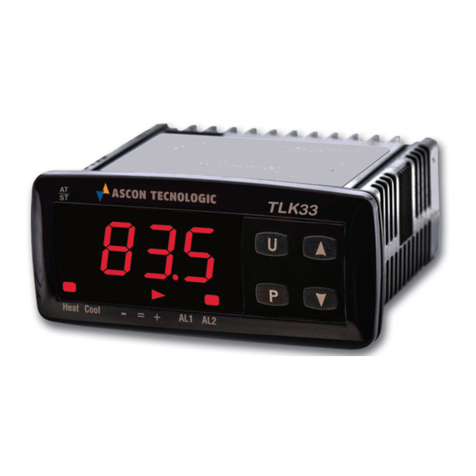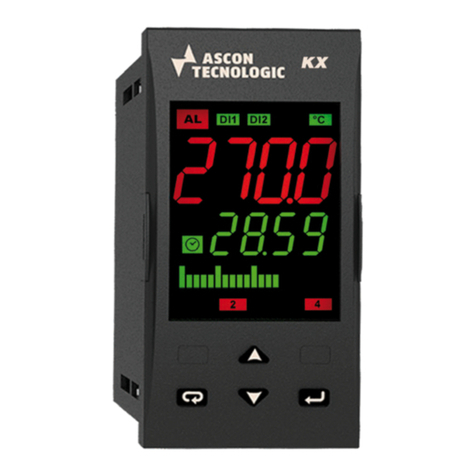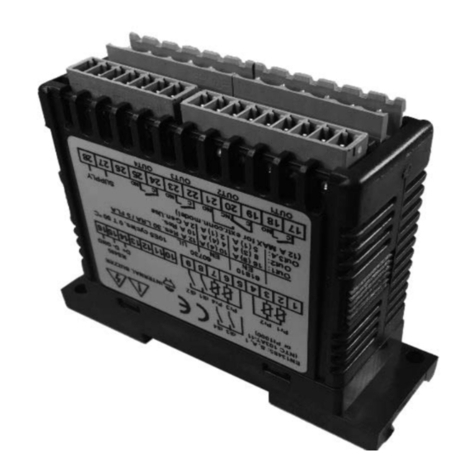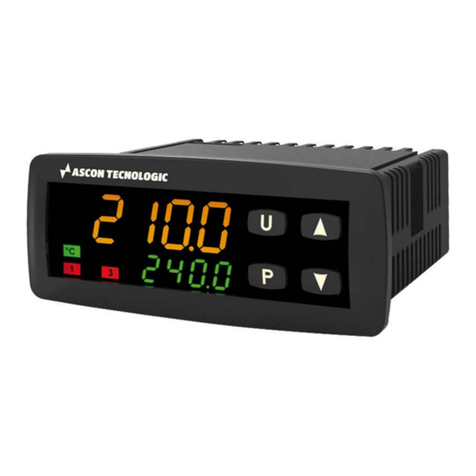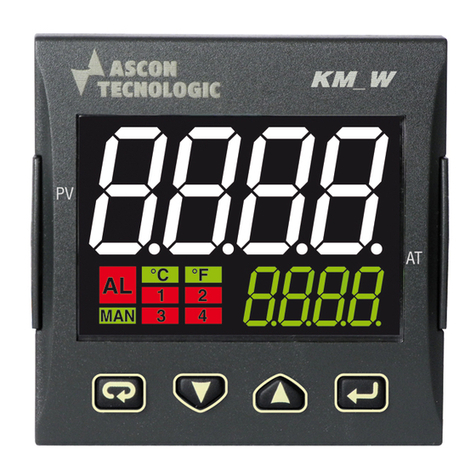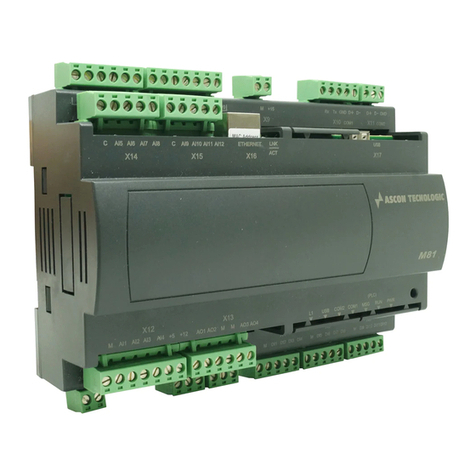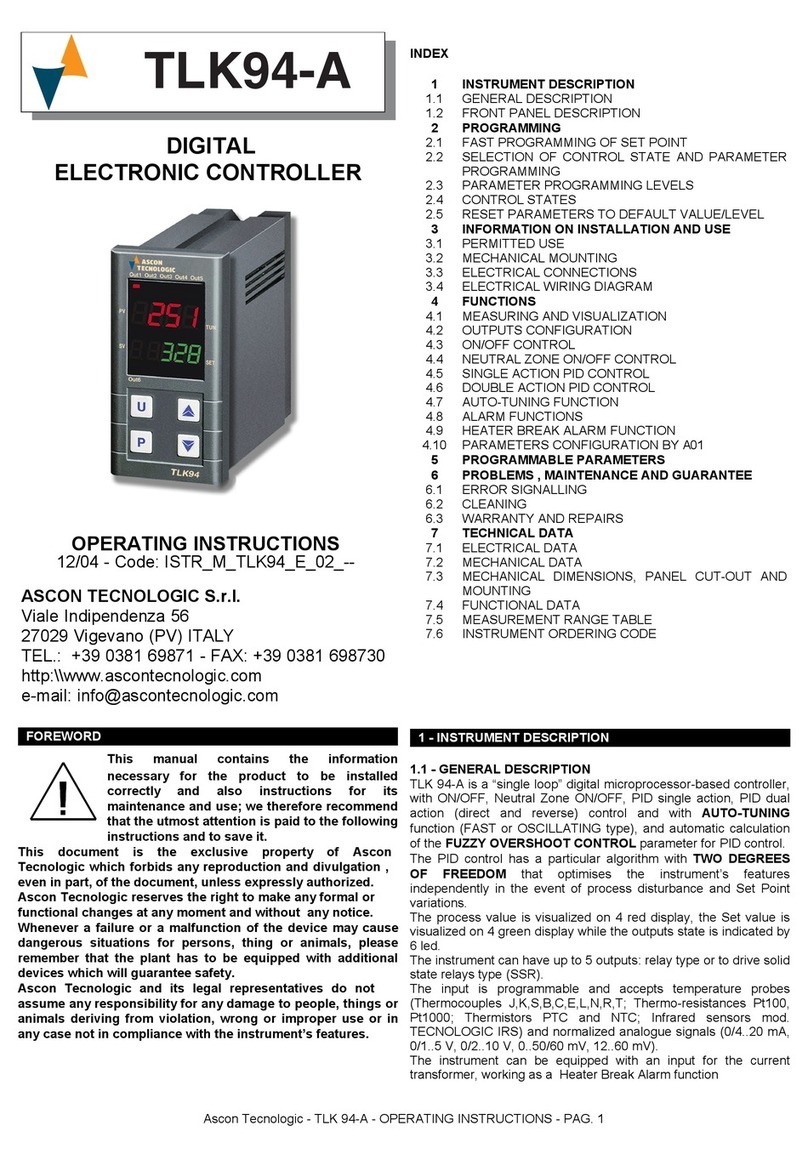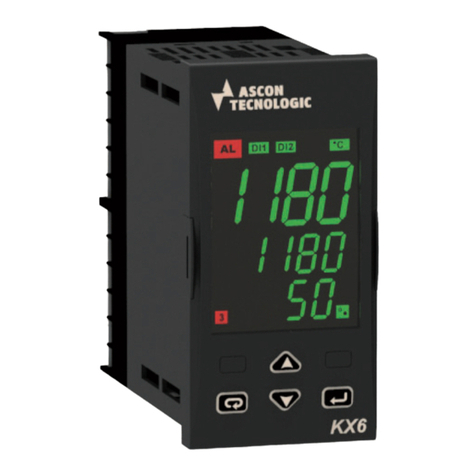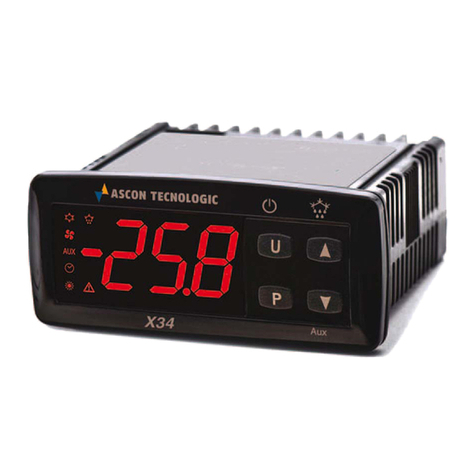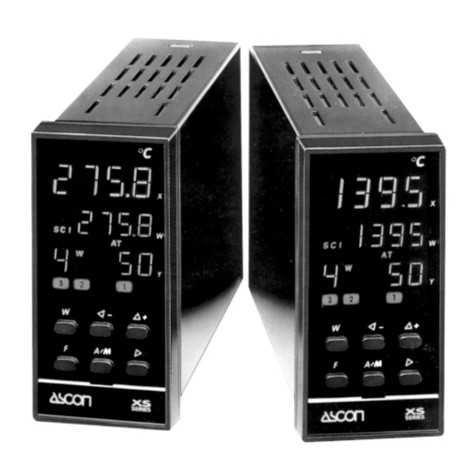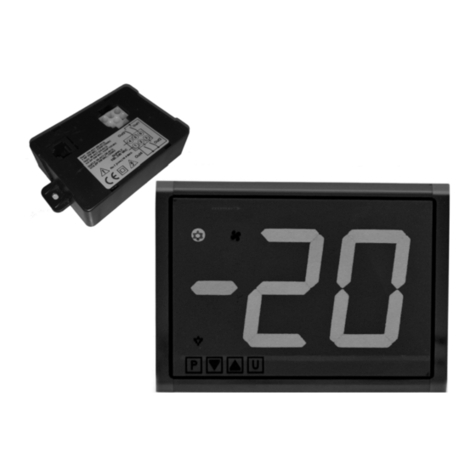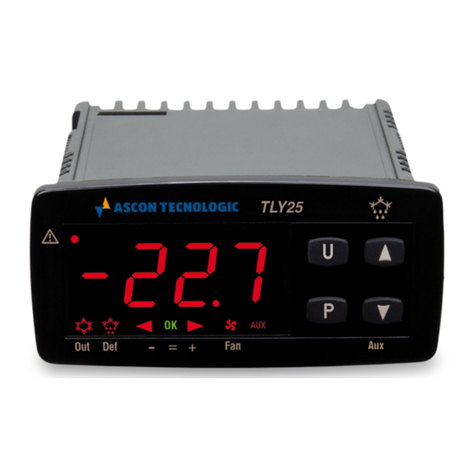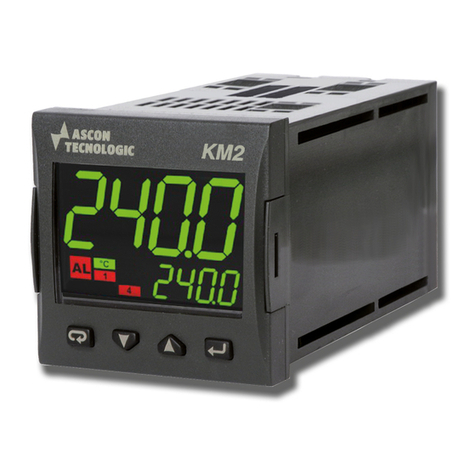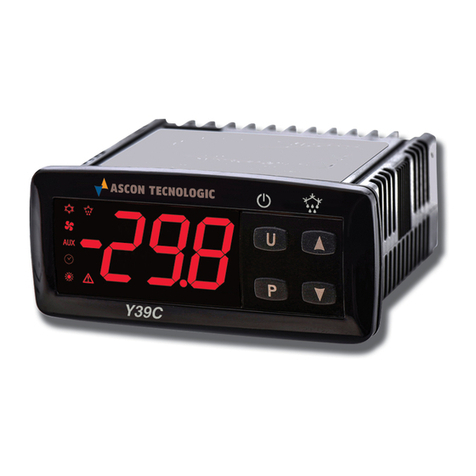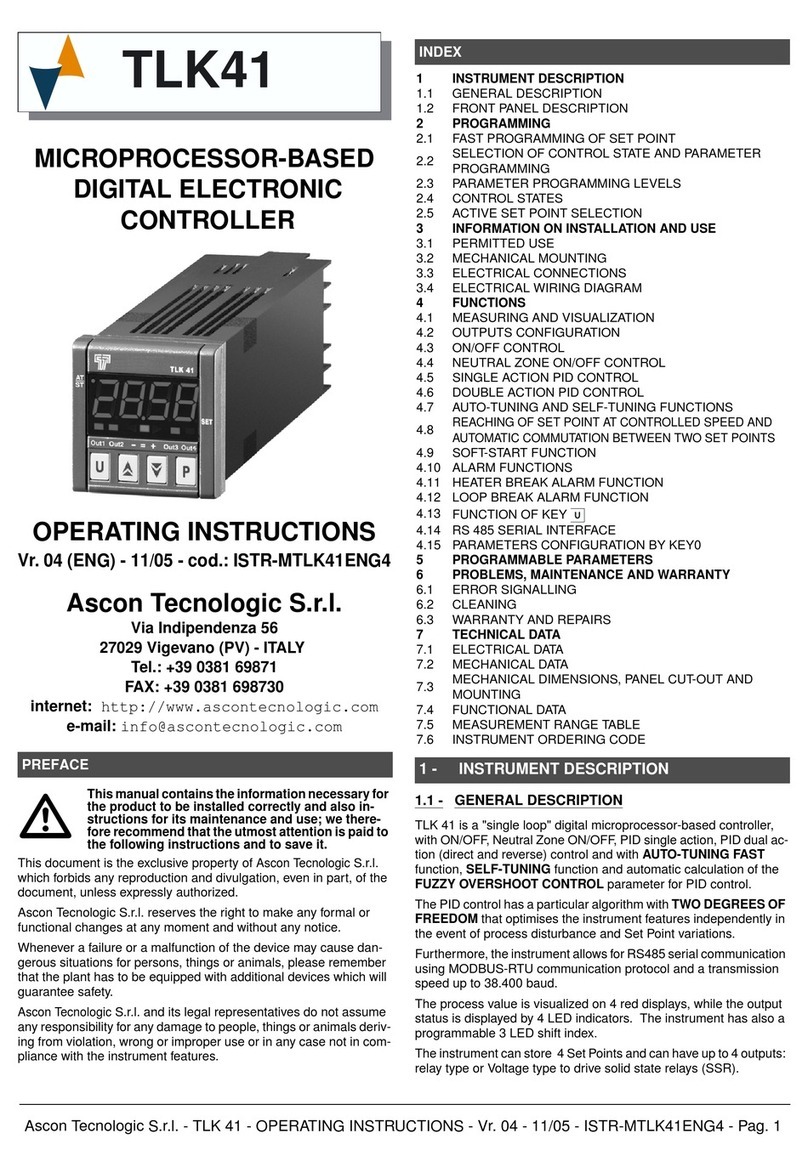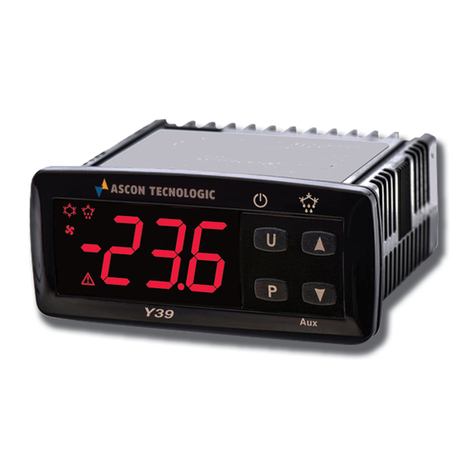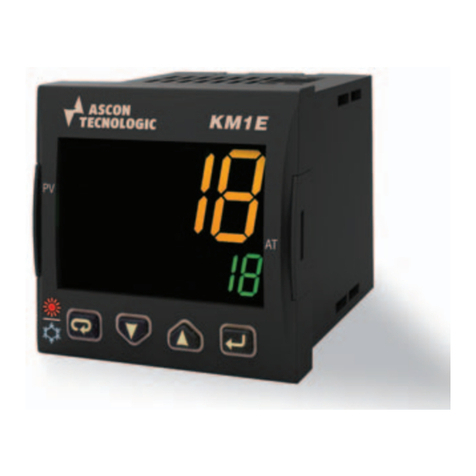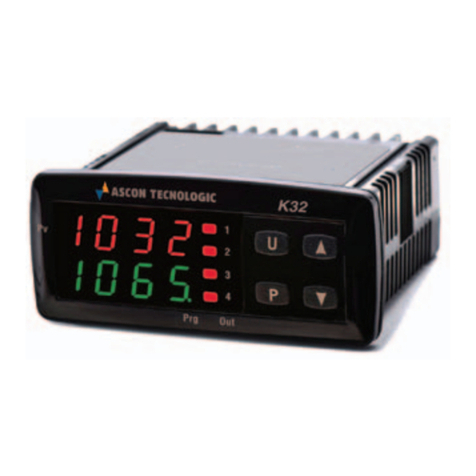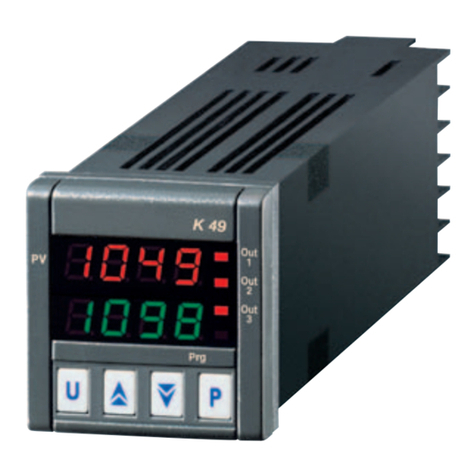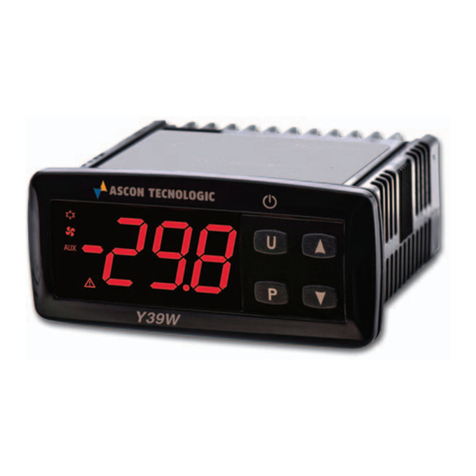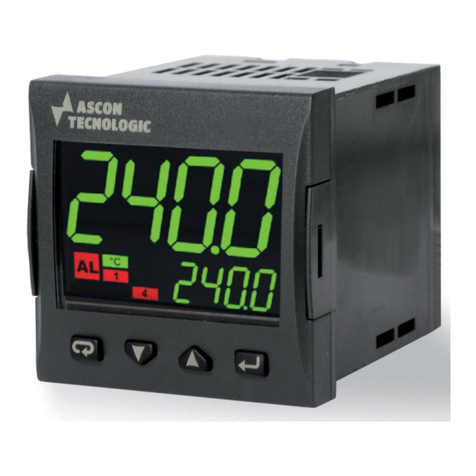
Ascon Tecnologic - X35- - OPERATING INSTRUCTIONS - PAG. 9
i.1t and i.2t.
In addition, the instrument may have 2 further voltage-free
digital inputs as an alternative to the measurement inputs
Pr3 and Pr4. In order to use these inputs digitally, the user
must set the relevant parameters i.P3 and/or i.P4 = dG.
The function performed by these digitally configured inputs
is defined by parameters i.3F and i.4F while their action is
instantaneous and cannot be delayed.
The parameters i.1F, i.2F, i.3F, i.4F can be configured for
the following functions:
0 No function;
1 Cell door opening sensor with NO contact: at input
closure the instrument alternately displays oP and the
variable set at i.dS parameter. This Digital Input func-
tion starts also the timer set with parameter A.oA elapsed
which the Open Door Alarm is activated. In addition, at
door opening, the controller returns to Normal mode if it
was in Eco mode and the Eco mode had been activated
by i.Et parameter;
2 Cell door opening sensor with fan stop with NO contact:
Similar to i.
o
F= 1, but with fans stop function. Once
elapsed the A.oA interval the controller activates the Door
open Alarm and restarts the fans.
3 Cell door opening sensor with compressor and fan stop with
NO contact: Similar to
i.
o
F=
2, but with compressor stop.
Once elapsed the A.oA interval the controller activates the
Door open Alarm and restarts the fans and the compressor;
4 External alarm signal with NO contact: at input closure the
alarm is activated and the instrument alternately shows
AL and the variable set at parameter i.dS.
5 External alarm signal with all control outputs disabled with
NO contact: at input closure the alarm is activated, all the
control output are disabled and the instrument alternately
shows AL and the variable set at parameter i.dS;
6 Normal/Eco mode selection with NO contact: at input
closure the Eco mode is activated. When instead the
contact is open Normal mode is activate.
7 Instrument ON/OFF (stand-by) selection with NO contact:
at input closure the instrument is switched ON while it is
placed in Stand-by mode when the digital input is open;
8 Turbo activation command with NO contact: at input clo-
sure the instrument starts a Turbo cycle;
9 AUX auxiliary output remote command of with NO contact:
at input closure the instrument activates the auxiliary
output as described in the o.Fo = 2operating mode of the
auxiliary output.
10 Disable recording of HACCP alarms with NO contact:
at input closure the instrument disables the recording of
HACCP alarms;
11 Reset recording of HACCP alarms with NO contact: at input
closure the instrument deletes all recorded HACCP alarms.
12 External PrA alarm signal and ot output disabled by
NO contact:
at input closure the instrument
deactivates
the output configured as ot and activates the alarm, the
instrument display shows PrA alternated with the variable
defined at i.dS parameter;
13 External HP alarm signal and ot output disabled by NO
contact:
at input closure the instrument
deactivates the
output configured as ot and activates the alarm, the
instrument display shows HP alternating with the variable
defined at i.dS parameter.
14 External LP alarm signal and ot output disabled by NO
contact:
at input closure the instrument
deactivates the
output configured as ot and activates the alarm, the
instrument display shows LP alternated with the variable
defined at i.dS parameter.
15 Forcing a programmed Switch-ON/Switch-OFF (Stand-
by) event with NO contact: the input closure of at least 1 s
switches the instrument from the ON to the Stand-by state
and vice-versa, until the next event. Therefore, if switch-
on/stand-by events are programmed using the clock, this
operation mode forces the state until the next event.
16 Defrost activation command with NO contact: at input
closure the instrument starts a defrost cycle;
17 End-Defrost command with NO contact: at input closure
if the defrost cycle is in progress the instrument stops it,
otherwise inhibits the defrost start;
18 Turbo cycle command with NO contact and mono-stable
command: at input closure the instrument starts a Turbo
cycle. Turbo mode remains active since the Digital Input
remains active and the r.tc time is elapsed. If the con-
tact is opened during r.tc time counting, the Turbo cycle
is interruppted. Elapsed the r.tc time count, in order to
start a new Turbo cycle it is necessay de-activate then
re-acivate the Digital Input.
19 Inhibition of events programmed by clock.
-1, -2, -3 etc.
Features identical to the above but obtained through
a NC contact and a reversed logic operation.
Note: Where multiple digital inputs are configured for the
same function, the instrument will treat the contacts
as if they were parallel (and consequently regard the
result as an OR function).
5.5 Outputs and buzzer configuration
All parameters concerning the outputs configuration are
contained in the ]Ou group.
The instrument outputs can be configured using parameters
o.o1, o.o2, o.o3, o.o4.
The outputs can be configured for the following functions:
ot Controls the compressor or however, the temperature
control device;
dF Controls the first defrost device;
Fn Controls the evaporator fans;
Au Controls the auxiliary device;
At Controls a silenceable alarm device through a contact
that is normally open and then closed when in alarm;
AL
Controls an alarm that cannot be silenced through a
contact that is normally open and closed when in alarm;
An
Controls an alarm with a memory function through a
contact that is normally open and closed when in alarm.
-t Control a silenceable alarm device through a contact
that is normally closed and then open when in alarm;
-L
Control an alarm that cannot be silenced through a
contact that is normally closed and open when in alarm;
-n
Control an alarm with a memory function through a
contact that is normally closed and open when in alarm;
on For controlling a device that must be active when the
instrument is ON. The output is therefore disabled
when the instrument is not powered or is in stand-by.
This mode of operation can be used as a lighting con-
trol for the showcase, anti-fog heaters or other utilities;
HE For controlling the heating device in neutral zone con-
trol mode (r.HC = nr);
2d Controls the second defrost device;
